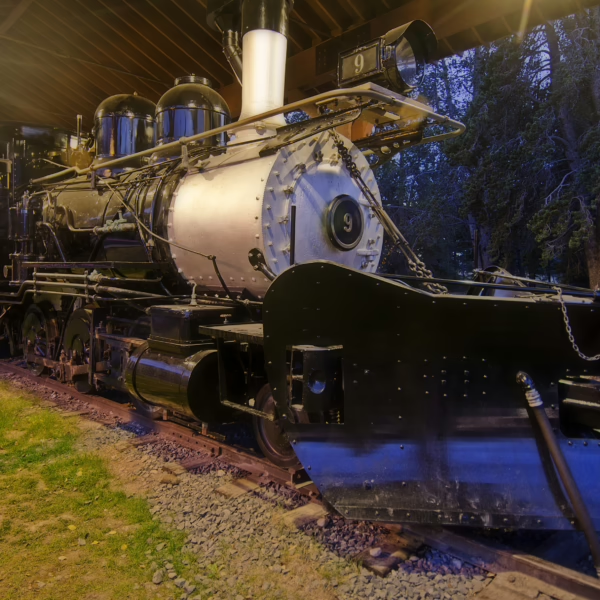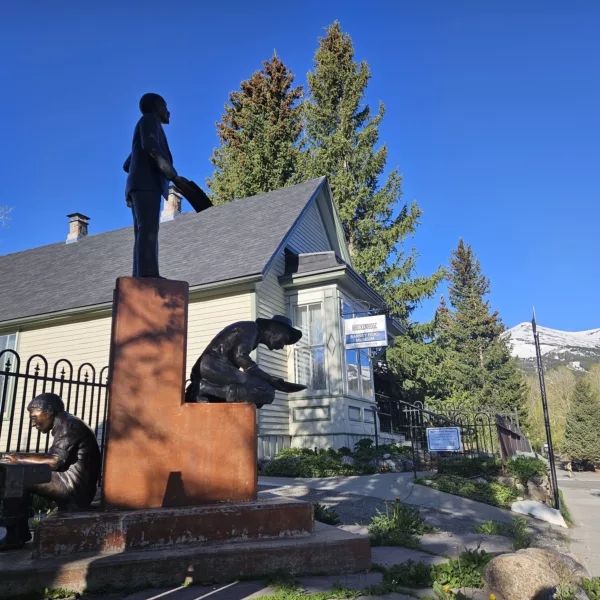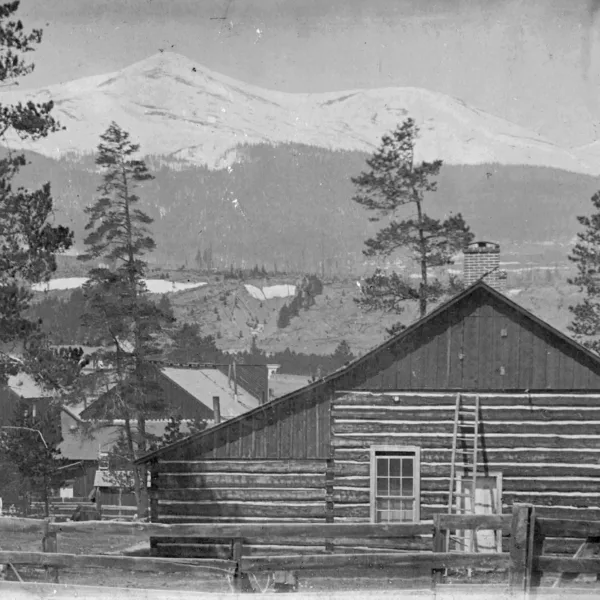Ferrocarril Denver, South Park & Pacific
March 24, 2022 | Category: Historia de Breckenridge
Las economías minera y agrícola del condado de Summit necesitaban un transporte barato y eficaz. Desde la primavera de 1859, cuando los buscadores encontraron oro por primera vez, un transporte adecuado y fiable significaba la diferencia entre la ventaja económica y el estancamiento. Sin él, el mineral, el heno, la madera, las ovejas y el ganado no podrían llegar a los mercados locales o lejanos; los alimentos, la ropa y los equipos y suministros mineros y agrícolas no estarían disponibles para quienes los necesitaran.
Aunque los trenes de carga y los vagones transportaban un asombroso tonelaje de mercancías y mineral hacia y desde el condado, algunas piezas del equipo minero resultaban demasiado pesadas y voluminosas. Los comerciantes y las minas necesitaban algo que pudiera transportar cargas más grandes con mayor rapidez y a menor coste, y ese algo era el ferrocarril.
La Denver, South Park & Pacific (DSP&P), creada por el gobernador John Evans en 1872, prestaba servicio a Breckenridge y sus alrededores. Pensando que los recursos minerales del condado resultarían rentables para el ferrocarril, la compañía decidió empezar a trabajar en una línea principal que ofreciera servicio de pasajeros y mercancías a los residentes. El editor del periódico escribió que "Breckenridge tendría unas instalaciones de distribución casi iguales a las de Denver".
El South Park comenzó a tender vías desde Como en 1881, llegando a Boreas Pass a finales de año; a Breckenridge en septiembre de 1882; y a Dillon en diciembre de 1882. Como se convirtió en el lugar de servicio y dotación de personal para los trenes. Los empleados del ferrocarril soportaban largas jornadas de trabajo, retrasos que a veces duraban horas e incluso días, la incertidumbre de las asignaciones y la falta de una rutina diaria. Las mujeres sacaban adelante a las familias. Se adaptaban a las tareas y a los retrasos, a veces preparando la comida en mitad de la noche. Cocinar, limpiar y hornear eran tareas diarias que a menudo se hacían en casas frías rodeadas de temperaturas bajo cero, vientos arremolinados y nieve durante los largos meses de invierno a 9.796 pies sobre el nivel del mar.
En 1881 se construyó una gran nave de seis naves. La necesidad de más espacio para reparar las locomotoras hizo que en la década de 1890 se añadieran trece naves de madera. La parte original de piedra de la casa de máquinas albergaba un taller bien equipado. Aunque un incendio consumió la parte de madera el 25 de marzo de 1935, ésta siguió sirviendo a las locomotoras.
El ferrocarril decidió entrar en el condado de Summit por el paso de Boreas. Hay que recordar que el condado de Summit no era el destino principal, sino las ricas minas de Leadville. El ferrocarril fundó la ciudad de Boreas en 1882 para alojar a los trabajadores durante y después de la construcción. Llamada así por el viento que soplaba constantemente a 11.481 pies de altura, la ciudad se convirtió en la estación ferroviaria más alta de Estados Unidos. Incluía un depósito, algunas casas de troncos, un almacén con tejado de tierra, una casa de telégrafos, una casa de sección al este de las vías y una enorme casa de máquinas de piedra con plataforma giratoria, carbonera y depósito de agua alimentado por manantiales. Un cobertizo para la nieve cubría 600 pies de vía. Cuando el cobertizo de nieve se quemó en 1899, el personal lo reconstruyó y añadió 397 pies. Otro cobertizo de nieve protegía una bifurcación y 1.566 pies de vía lateral.
Los ferrocarriles de montaña de Colorado tendían sus vías a un metro de distancia. La vía estrecha ofrecía ventajas: curvas más cerradas, traviesas más cortas, motores y material rodante más pequeños y ligeros. Para ahorrarse los gastos de construcción y nivelación de una nueva vía, la empresa compró la antigua carretera de peaje del paso de Boreas. Las cuadrillas clavaron los raíles en traviesas sin tratar de abeto y pino amarillo separadas 18 pulgadas. Las cenizas del hogar, vertidas a lo largo de las vías, se convirtieron en el balasto. Las vías se doblaban y hundían, los vagones se balanceaban y se tambaleaban. La velocidad máxima de los trenes de pasajeros era inferior a 22 millas por hora y la de los trenes de mercancías era inferior a 12 millas por hora en el paso de Boreas.
Tras llegar a Breckenridge en agosto de 1882, la DSP&P continuó hasta Dillon y Keystone, pero la línea principal giró hacia Frisco en Dickey y sirvió a las minas del cañón Ten Mile antes de cruzar el paso de Fremont en Climax. Debido a que las vías cruzaban la divisoria continental dos veces al entrar y salir del condado, el ferrocarril pasó a conocerse como High Line.
Dickey se convirtió en el punto de cambio entre la línea Dillon y la línea Frisco. En 1902, el ferrocarril construyó un depósito de carbón, un depósito de agua de 47.500 galones, una tolva de carbón de 12 bolsillos y vías laterales para 188 vagones. Los trabajadores construyeron una vía de enlace y una casa redonda (1902) con dos casetas para albergar cuatro locomotoras auxiliares necesarias para el viaje por los pasos de Boreas y Fremont.
La naturaleza jugó en contra de los ferrocarriles. El frío, el viento, la nieve, las inundaciones, los corrimientos de tierra y las avalanchas, a menudo provocadas por el estruendo de las locomotoras y los silbatos, aumentaban los costes de explotación y ponían en peligro a trabajadores, viajeros y equipos. Mantener las vías limpias de nieve, hielo y rocas podía ser casi tan difícil como tenderlas. La nieve era el mayor problema. Las vías se despejaban con enormes arados de cuña, tan grandes que ocultaban el motor que los empujaba. Para las mayores acumulaciones de nieve, un arado giratorio, parecido a un ventilador en la parte delantera de un vagón, la retiraba de la vía. Una caldera de carbón accionaba el arado, pero el vagón tenía que ser empujado por cuatro o seis locomotoras. La última podía estar orientada hacia atrás para sacar el rotativo si se quedaba atascado. Las ruedas delanteras rascaban el hielo de las vías. El ferrocarril contrataba palafreneros, que vivían en un vagón convertido en caja al final del tren de arado, para ayudar a la rotativa a atacar las derivas.
El invierno de 1899 presentó especiales dificultades para los habitantes del condado. El 6 de febrero el último tren cruzó el paso de Boreas. Para el 29 de febrero, los palafreneros abrieron un camino de trineos sobre el paso porque el ferrocarril no podía pasar, ni siquiera con arados de cuña y rotativos. La comida para humanos y animales empezó a escasear. Cientos de kilos de correo no pudieron ser entregados. Tras varios intentos, el 24 de abril los hombres finalmente alcanzaron el arado rotatorio atascado en Barney Ford Hill. El bloqueo había durado 78 días.
Los problemas financieros dictaron cambios corporativos. La Denver, South Park & Pacific se convirtió en la Denver, Leadville & Gunnison en 1889. Colorado & Southern compró la empresa en dificultades en 1898 para venderla a Chicago, Burlington & Quincy en 1908. A pesar de los nuevos propietarios, la gente seguía refiriéndose a la compañía como Colorado & Southern. Los propietarios no tenían interés en mantener la línea debido a los elevados gastos de explotación. Los vagones se llenaban de poco mineral de alta ley. Los nuevos métodos de concentración hacían que hubiera menos mineral que transportar. La electricidad, disponible en Breckenridge en 1892, redujo la necesidad de carbón, una gran parte del tonelaje transportado en los trenes entrantes. Coches, camiones y autobuses sustituyeron al ferrocarril como principal medio de transporte de personas y mercancías.
A principios de siglo, Colorado & Southern intentó reducir el servicio al condado. El ferrocarril subió las tarifas y redujo los horarios; siguió utilizando motores y material rodante ineficaces y viejos. La compañía recurrió a numerosos tribunales y organismos gubernamentales, pero el condado obtuvo indulto tras indulto. Todos sabían que las victorias no continuarían.
No se puede subestimar el impacto del ferrocarril. Determinó la ubicación de ciudades como Dillon y de sus negocios. En Breckenridge, los almacenes y depósitos se alineaban a lo largo de las vías al oeste del río Blue. Vinculó a los residentes con los servicios de Denver y Leadville. Las dietas cambiaron cuando el ferrocarril trajo frutas y productos frescos de los asentamientos mormones de Utah. Debido a la necesidad de mantener sus horarios, el ferrocarril trajo la hora estándar a los pueblos a lo largo de las vías. El mineral podía llegar más rápidamente a las fundiciones y molinos; el mineral de baja ley reportaba mayores beneficios debido a los menores costes de transporte. Las tarifas de las excursiones y los hoteles construidos para alojar a los turistas fomentaron el turismo.
Aun así, empresarios y mineros sufrieron las consecuencias de las elevadas tarifas, el mal mantenimiento de los equipos y los horarios limitados. Cuando el servicio ferroviario murió, también lo hizo gran parte de la economía del condado de Summit. Muchos culparon de la desaceleración económica de principios del siglo XX a la reducción del servicio ferroviario. A medida que se evaporaban los puestos de trabajo en las minas, la población se desplazaba y los negocios se resentían.
Colorado & Southern abandonó finalmente su línea en 1937. La locomotora 9 transportó los últimos pasajeros y mercancías de Como a Leadville y viceversa los días 9 y 10 de abril de 1937. Las cuadrillas retiraron los raíles y las vías al año siguiente. La High Line desde Boreas Pass hasta Fremont Pass pasó a ser sólo un recuerdo.
escrito por Sandra F. Mather, PhD




